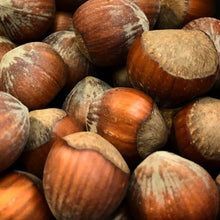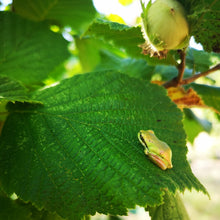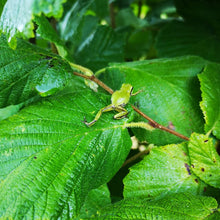
|
Mature height x width: |
approx 15' x 15' |
|
Recommended initial spacing: |
5'-10' in rows 20' apart |
|
Recommended final spacing: |
5' (hedgerow) / 10-20' x 20' (orchard) |
| Hardy to: | approx -35°C (-30) |
|
Preferred soil: |
deep loam |
|
Good for: |
riparian areas, partial shade, small garden, low-maintenance, high yield, storage |
|
Uses: |
oil, dessert, main dish |
Hazelnuts are productive, multi-purpose trees. Orchards prune to a tree form to maximize production, while shrubby hazelnuts are useful as windbreaks, privacy screens, hedgerows, erosion control, and living fences. Hazels can grow to 20+ feet, but they can also be kept significantly smaller with regular pruning or coppicing. They grow as an understory and forest edge tree in their native habitats, so they are tolerant of partial shade. For these reasons, they are an excellent choice for backyard growers without a lot of space. They are also grown commercially in this region, especially in Oregon. They are wind-pollinated so at least two trees are required. Plant densely to form a hedgerow or border at property line. Tolerant of wet soil as long as it drains in the spring (we've observed healthy trees in standing water during dormant months). Final spacing is highly variable depending on your goals. Space very densely (5') for a living hedge or privacy screen and thin or coppice as needed. Final orchard spacing is 10'-20 x 20'.
Genetics: The parent of these seedlings is compact and productive with large nuts. While the blight-resistance of these trees is not guaranteed, the parent tree is highly resistant to Eastern Filbert Blight.
Why seedlings? Growing seedlings from high-quality parents helps maintain diversity (each seed is a new variety) while drawing on some of the best genetics for hazelnuts in North America. In other words, by planting some of these seedlings, you are participating in the breeding new, regionally-adapted hazelnut varieties! In addition to variations in blight resistance, some trees may produce smaller or fewer nuts, so we recommend planting several of these trees closer together and selecting your final tree once they've produced their first nuts. Compared to clonally propagated trees, seedlings tend to have more robust root systems, increased vigour and drought-tolerance.
Why bare root? "Bare root" means that the tree has been grown in the ground (rather than in a pot). In general, bare root trees tend to have larger root systems because their roots aren't constricted by the edges of the pot. Because we don't need to use pots or potting soil, we can sell them more cheaply than potted trees. Bareroot trees must be planted when they are still dormant (Nov - Mar in our region).








